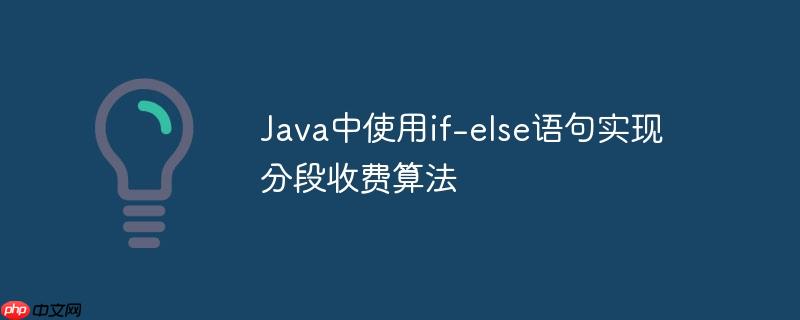
本文详细介绍了如何使用Java中的if-else语句来实现一个分段收费算法。该算法根据支票金额的不同,收取不同的服务费用。文章将提供完整的代码示例,并解释代码的逻辑和注意事项,帮助读者理解和应用if-else语句解决实际问题。
在软件开发中,经常会遇到需要根据不同的条件执行不同操作的情况。if-else语句是Java中实现条件分支的重要工具。本教程将以一个实际的分段收费场景为例,讲解如何使用if-else语句来实现复杂的逻辑判断。
场景描述:
假设我们需要为支票兑现服务收取服务费。服务费的计算方式如下:
立即学习“Java免费学习笔记(深入)”;
- 支票金额小于10美元,收取1美元服务费。
- 支票金额大于10美元且小于100美元,收取支票金额的10%作为服务费。
- 支票金额大于100美元且小于1000美元,收取5美元加上支票金额的5%作为服务费。
- 支票金额大于1000美元,收取40美元加上支票金额的1%作为服务费。
代码实现:
以下是使用Java if-else语句实现上述分段收费逻辑的代码示例:
public class ServiceCharge { public static void main(String[] args) { double amount = 500.0; // 支票金额,可以根据实际情况修改 double serviceCharge = 0.0; // 服务费 if (amount > 1000) { serviceCharge = 40 + (amount * 0.01); } else if (amount > 100) { serviceCharge = 5 + (amount * 0.05); } else if (amount > 10) { serviceCharge = amount * 0.1; } else { serviceCharge = 1; } System.out.println("支票金额: " + amount + " 美元"); System.out.println("服务费: " + serviceCharge + " 美元"); } }
代码解释:
- 变量声明: 首先,我们声明了两个double类型的变量:amount用于存储支票金额,serviceCharge用于存储计算出的服务费。
- if-else结构: 代码使用了一系列的if-else if-else语句来判断支票金额所属的区间,并根据不同的区间计算服务费。
- 条件判断顺序: 需要注意的是,if-else if语句的条件判断顺序很重要。从最大金额的区间开始判断,可以避免一些潜在的逻辑错误。 例如,如果先判断amount > 10,那么所有大于10的金额都会进入这个分支,导致后面的判断失效。
- 服务费计算: 在每个条件分支中,根据对应的收费规则计算服务费,并将结果赋值给serviceCharge变量。
- 输出结果: 最后,使用System.out.println()语句将支票金额和服务费输出到控制台。
注意事项:
- 数据类型: 在本例中,我们使用了double类型来存储金额,因为金额可能包含小数。在实际应用中,需要根据具体需求选择合适的数据类型。 如果需要精确计算,避免浮点数精度问题,可以考虑使用BigDecimal类。
- 边界条件: 在编写if-else语句时,需要特别注意边界条件的处理。例如,当支票金额恰好等于10、100或1000时,应该如何计算服务费? 代码中使用的>和<符号决定了边界值属于哪个区间。
- 代码可读性: 为了提高代码的可读性,可以使用注释来解释每个条件分支的含义和计算逻辑。 也可以使用更具描述性的变量名,例如checkAmount代替amount。
总结:
通过本教程,我们学习了如何使用Java中的if-else语句来实现一个分段收费算法。if-else语句是Java中进行条件判断的重要工具,掌握它可以帮助我们解决各种复杂的逻辑问题。在实际开发中,需要根据具体的需求和场景,灵活运用if-else语句,编写出高效、可读性强的代码。


评论(已关闭)
评论已关闭